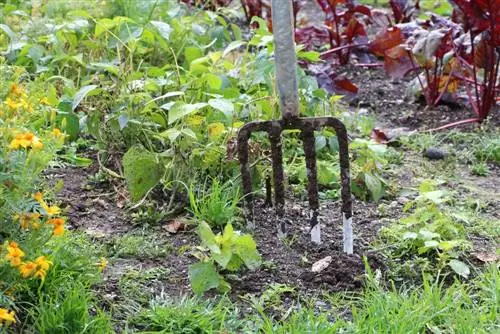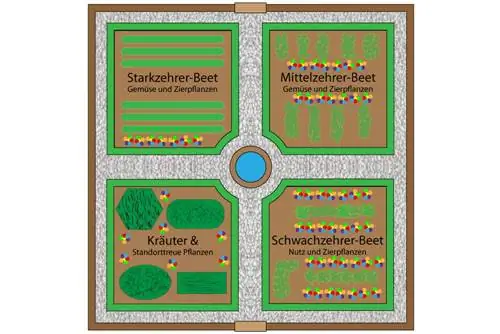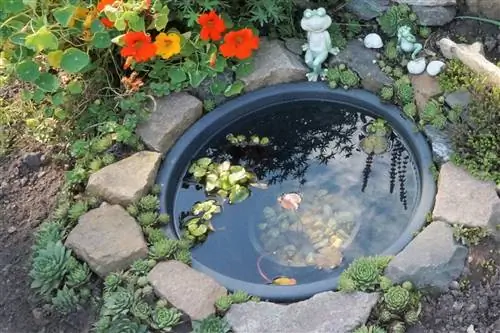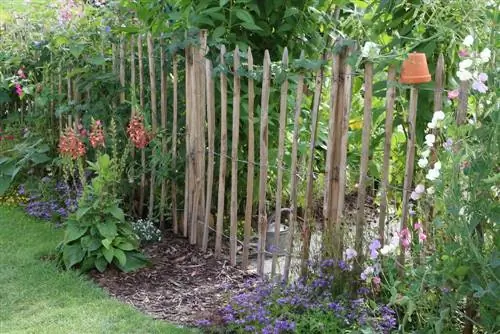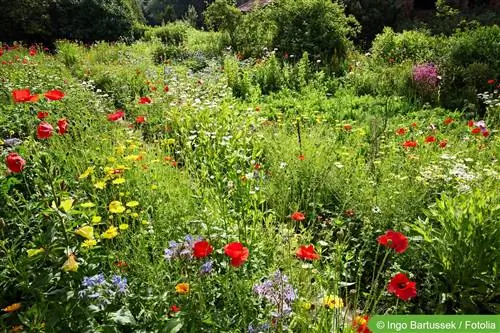- Author admin [email protected].
- Public 2023-12-17 03:39.
- Last modified 2025-01-24 12:45.
The natural hedge plays a key role in the naturally designed garden. As a composition of native, fruit-bearing trees, it serves as an ecologically valuable habitat and food source for the garden's animals. Birds, insects and small animals find shelter, feed on leaves, flowers and berries and raise their offspring. Hobby gardeners who create a natural hedge make an important contribution to maintaining the biological balance in their green kingdom. Immerse yourself in the wide variety of suitable hedge plants here. Be inspired by a varied planting plan.
Basic concept of a natural hedge
To create an authentic appearance, a natural hedge should not be laid out in a straight line. A slightly offset course in a serpentine or zigzag line is recommended. If you also design the planting plan in three levels, you not only emphasize a relaxed look, but also create a depth effect. All in all, a successful planting plan combines the following attributes:
- Only native trees
- Flowering bushes with fruit hangings
- Staggered flowering periods throughout the year
- Incorporate fast-growing, medium-high deciduous trees
- Individual conifers underline the natural character
- Curved instead of straight arrangement
- Construction over three levels with increasing levels towards the back
- Underplanting with ground cover or mulching with pine bark
- Plant shrubs with similar growth rates in groups
If the natural hedge is located in a garden where there are children or pets, the toxic content of shrubs must be taken into account when drawing up the planting plan. Various trees bear fruit that birds like to eat, while they are unhe althy or even poisonous for humans.
Ideal hedge plants
The following trees represent a selection with different flowering times, spread over the seasons. Some candidates with magnificent foliage color are also represented, so that the natural hedge also creates a colorful picture in autumn. It is important to note the integration of berry bushes, which bear fruit well into the winter, so that the birds can still find food at this time. One or two conifers should also be allocated a place, because in the wild coniferous trees often mix with leafy bushes.
Common Viburnum (Viburnum opulus)
Its attributes make the shrub the ideal hedge plant. It impresses with white flowers from May to June, red fruit in autumn and colorful foliage. With a height of 2 to 4 meters, it is suitable for the second or third level because it tolerates cutting very well and grows quickly.
Blackthorn (Prunus spinosa)
The shrub is extremely popular with birds, thanks to the rich fruits that serve as food well into the winter. They also like to nest here because the black thorns keep predators at a safe distance. Bees and bumblebees are happy about the early blooms in April. The growth height of 1.50 to 4 meters can be easily regulated through pruning measures - it grows slowly.
Farmer's Jasmine (Philadelphus coronarius)
Lots of fragrant individual flowers decorate the shrub in May and June. Thanks to its tight, upright habit with slightly overhanging branches and a growth height of up to 3 meters, it is ideal for growing in the middle level of a natural hedge.
Black Elderberry (Sambucus nigra 'Black Beauty')
Here, pink flowers and red slitted leaves attract everyone's attention. The fast-growing flowering shrub also scores points with its delicious fruit berries. As long as the location is sunny to partially shaded, it thrives in any good garden soil.
Field maple (Acer campestre)
Its blossom in May is hardly worth mentioning; The field maple makes up for this with a breathtaking growth rate and an astonishing tolerance for pruning. This deciduous tree with its shrub-like habit should therefore not be missing from any natural hedge, especially as it offers excellent wind protection for humans and animals.
Rock Pear (Amelanchier lamarckii)
An enchanting, multi-stemmed shrub with wonderful flowers in spring, blue-black fruits and fantastic foliage color in autumn. With its loose silhouette and a height of 3 to 4 meters, the flowering shrub provides opulent abundance in every natural hedge and at the same time provides insects and birds with lots of delicacies.
White Dogwood (Cornus alba Elegantissima)
The enchanting ornamental shrub provides a pretty splash of color with variegated foliage that turns carmine red in autumn. With its red shoots, the tree ensures a decorative appearance even during the barren winter period.
Cornelian cherry (Cornus mas)
The cornelian cherry rings in the gardening year with a golden-yellow umbel blossom in March and April, which is of course particularly pleasing to insects. The cherry-like fruits are rich in vitamin C and are also ideal for hobby gardeners to snack on. The wild tree is extremely robust, extremely undemanding and resistant. This ensures reliable stability in every natural hedge.
Mayflower Bush (Deutzia gracilis)
Its growth height of up to 100 centimeters qualifies the ornamental shrub as the perfect candidate for the first level in a natural hedge. The tree enchants with white flower spikes from May to June, accompanied by elongated, dark green foliage.
Dwarf Lilac (Syringa Palibin)
Another dwarf for the front row in a natural hedge will, with a little luck, even bloom twice a season. Different varieties also spread an intoxicating scent that bees and butterflies eagerly fly to. With a maximum height of 150 centimeters, the pastel-colored flowers stand out particularly well against a dark backdrop.
Hazelnut (Corylus avellana)
An indispensable part of a natural hedge, it is an undemanding pioneer plant and a source of nuts for birds and small animals. The first insects of the year, such as the colony-forming queen bees, also celebrate the very early flowering from February onwards. The powerful growth can be easily kept under control thanks to the flexible pruning tolerance.
Magic Nut (Hamamelis intermedia 'Fire Magic')
Would you like a fragrant blossom in the middle of winter? The native witch hazel likes to fulfill this wish in the natural hedge and thus creates a visual highlight in the dark season for people and animals in January and February with wine-red petals. The undemanding ornamental tree even manages without any pruning.
Creative hobby gardeners weave evergreen shrubs into the planting plan, which ensure consistency in the overall appearance of a natural hedge. Perennial arborvitae are just as suitable here as noble boxwoods or slender columnar cypresses.
Conclusion
The natural hedge combines a variety of ecologically valuable attributes for the benefit of people and animals. The aim is to create an authentic composition of flowering, fruit-bearing trees from the region, which come together in several levels over a curved path. If staggered flowering times, colorful autumn leaves and variable growth rates are mixed in with the characteristics, an individual planting plan is created, as if from the hand of Mother Nature.


